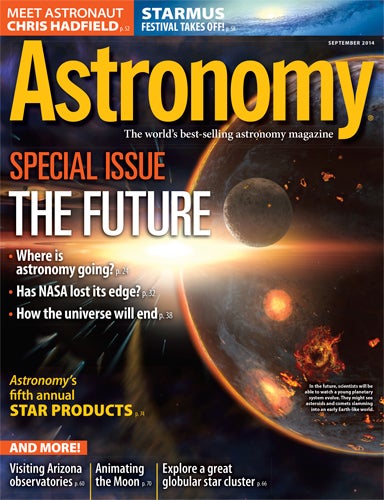
Astronomy offers you the most exciting, visually stunning, thorough, and timely coverage of the heavens above. Each monthly issue includes expert science reporting, vivid color photography, complete sky-event coverage, spot-on observing tips, informative equipment reviews, and more. All of this comes in an easy-to-understand user-friendly style that’s perfect for astronomers at any level. Contact Astronomy, the world’s best-selling astronomy magazine, at 262.796.8776 or email editor@astronomy.com.
WAUKESHA, Wis. – Where is astronomy headed? What will the next great discoveries be? Who will fund upcoming missions, and what will their focus be? And, looking more broadly, what does our future hold?These are just some of the many questions facing scientists in the 21st century. And in a special September issue, Astronomy magazine tackles them all in three forward-thinking articles. Freelance science writer Sarah Scoles kicks things off by asking 20 leaders in the astronomy world to predict what the next five decades will hold for the field. From exoplanets to gravitational waves and everything in between, the intrigue of the unknown and ambitious optimism abounds – with one caveat: funding.Receiving money for large-scale astrophysics and planetary science missions has been a problem of late, especially in the United States. NASA is still the leader in space science and exploration, but other agencies are gaining ground. Associate Editor Liz Kruesi investigates this trend, looking into what programs Europe, Russia, China, Japan, and India have planned for the next few decades compared to what’s in NASA’s budget.But what will the upcoming centuries and millennia, not just the next few decades, bring to our planet and the greater cosmos? Big changes to our neighborhood and the galaxy and universe at large are coming. To wrap up this special issue, NASA senior science writer Francis Reddy explores what scientists have been able to predict about the fate of Earth, the Sun, the Milky Way, and even the cosmos. Sneak peak: It looks pretty dark.So pick up the September issue of Astronomy, on newsstands August 5, to delve into the future of astronomy and see what the science might have to offer both us and future generations.
“Animating the Moon”
Drawing what you see at the telescope can help you observe finer detail and can make your observing sessions more useful. They also can lead to new challenges at the eyepiece that keep your sessions under the stars exciting. In “Animating the Moon,” contributor Erika Rix has your next adventure: sketching the Moon throughout an entire lunar month and then stitching together your results into a movie. Find out how Rix successfully completed the task, including what supplies she used and how she dealt with a moving target, and get ready for your own undertaking!
“Astronomy‘s fifth annual Star Products”
Can’t decide on your next astronomy equipment purchase? Look no further than “Astronomy’s fifth annual Star Products.” In this special equipment review section, Contributing Editor Phil Harrington guides you through 35 of the best astronomy gadgets and gizmos on the market today, including nine telescopes, three cameras, and lots of great accessories.
September sky events visible without optical aid
- September 1 – The Aurigid meteor shower peaks.
- September 21 – Mercury appears at its best in the evening sky this fall.
- September 27 – Saturn joins a crescent Moon while Mars and the bright star Antares compete with each other.
Also in the September 2014 Astronomy
- “Meet astronaut Chris Hadfield” – This Canadian has flown more than 70 planes, has been in space three times, and is the only accomplished guitarist at zero g.
- “Starmus Festival takes off!” – The beautiful Canary Islands are set to host astronomy’s most amazing event, where you can mingle with astronauts, Nobel Prize winners, and rock stars – and see the world’s largest optical telescope!
- “Of star parties and star seekers” – Astronomy‘s public star party gave way to incredible visits to Kitt Peak, MMT, and the Whipple Observatory this past winter.
- “All about 47 Tucanae” – This southern-sky wonder is beautiful for amateurs to look at and even better for scientists to study.
- “The Sky this Month” – Exclusive star charts will guide you through September’s night sky.
- The September issue of Astronomy also includes Astro News, Ask Astro, Snapshot, Breakthrough, Bob Berman’s Strange Universe, Stephen James O’Meara’s Secret Sky, Glenn Chaple’s Observing Basics, Adam Block’s Cosmic Imaging, Erika Rix’s Astro Sketching, Cosmic World, Letters, Web Talk, New Products, Reader Gallery, and Final Frontier.









